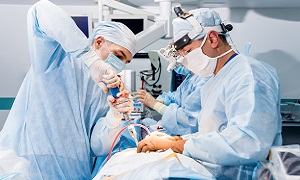Laminotomy
Laminotomy is a surgical procedure for removing part of the lamina of a vertebral arch for relieving pressure in the vertebral canal. This procedure is comparatively less invasive as compared to conventional vertebral column surgeries such as Laminectomy, as this procedure leaves more muscles and ligaments attached to the vertebral column intact. In this procedure, less bone removal is required.
If you are suffering from spinal stenosis, i.e. narrowing of the spinal canal, then Laminotomy might help to relieve pressure on your spinal cord.
Purpose
The purpose of the laminotomy procedure is to relieve a compressed nerve that occurs at the back of your spinal cord. Your lamina is a small bone that is on the back of each vertebra, which joins together to form the back wall of the spinal canal. Sometimes, some conditions can force the lamina to compress one of the nerves that are situated in the spinal canal, which may lead to discomfort, specifically in a leg or an arm. Spinal stenosis is the most common reason for this or in some cases, a narrowing in the spinal canal.
Other serious ailments which can be treated by this surgery include herniated disk, bulging disc, degenerative disc disease or arthritis or the spine. If you experience pain, especially due to spinal stenosis or any of these ailments, you might be a candidate for laminotomy.
Each person’s symptoms generally vary due to the severity of the condition, as well as the medical history of the patient. However, this condition is generally meant to treat a few problems, such as strong pain in the lower back, weakness in the arms or legs or issues maintaining balance.
Laminotomy can be performed with minimally invasive methods requiring small incisions, using a microscope.
Since it involves less muscle disruption, you should expect faster recovery and shorter stay in the hospital. You should be able to return to work and your daily routine quite quickly.
Preparation
You will need to let your health providers know about your medications if you take any, including herbal supplements. If you also have any allergy to the anesthetic, you will need to inform them about this as well.
It is also important to stop smoking for the days prior to your surgery, as this can interfere with the healing process.
You’ll need to avoid any kind of food or drinks for a certain amount of time before your surgery.
Procedure
During this procedure, first, you will lie face down on the surgical table after the doctor puts you asleep using general anesthesia. Then with the help of an X-ray, the surgeon identifies the problem of the spine.
A small incision is next made on the back and the muscles are either lifted off the bone or gently moved apart with the help of a tubular retractor. This helps the doctor gain access to your spine.
Once your doctor has access to your spine, he/she can use a high-speed drill to create a hole in the lamina. The ligament of the spine is next lifted up off the spinal cord.
After this, the surgeon will decompress one of both sides if required, as this helps ensure that any bone or material leading to compressing is removed up off the spinal cord and nerve roots.
After the surgery is complete, you will need to be monitored by the healthcare team for some time. You will be asked to walk as soon as you feel comfortable so that they can ensure that the procedure is a success. Patients are generally able to leave the hospital the same day.
Recovery
Over 95 percent of patients having this procedure are able to return home the same day.
For two or three days, you might experience mild pain at the incision site. This is treatable with pain medicine.
Most of the patients are quickly able to find relief from their symptoms. Physical recovery is required for a total recovery. It should take around three to six weeks.
Infrequent tingling, numbness or shooting pains after the surgery should improve over time and physical therapy, as your nerve continues healing.
Patients are encouraged to walk as much as possible. However, they need to avoid bending, twisting or lifting heavy weights.
Risks and complications
Like all surgeries, there are some risks and complications that are involved with Laminotomy. They include-
- Reaction to anesthesia
- Bleeding which can cause a shock
- Blood clots developing in the leg or pelvis
- Infection
- Nerve and blood vessel damage
- No pain relief or little pain relief after the surgery
- Recurrent symptoms
- Spinal nerve injuries leading to weakness, pain or numbness
Inform your doctor immediately, if you have any concerns, such as bleeding, fever, an increase in pain or wound redness, drainage, or swelling. It is important that you take your medications as directed.


